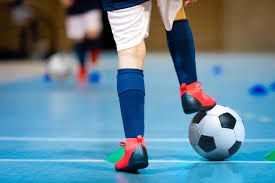Futsal is a five-a-side indoor football game played on a hard surface, typically within a netted or walled court. The ball is smaller and has less bounce, which encourages close control and sharp passing.
Here’s how it stands apart from traditional soccer:
| Feature | Futsal | Soccer |
|---|---|---|
| Team Size | 5 players per side | 11 players per side |
| Ball | Smaller, low bounce ball | Standard size, high bounce |
| Playing Surface | Indoor court | Grass or turf |
| Game Speed | Fast-paced, high tempo | Slower, more strategic build-up |
| Skill Emphasis | Technique, agility, passing | Power, endurance, tactics |
Kids who play futsal tend to touch the ball more often, stay engaged throughout, and develop rapid decision-making skills.
Why are more Aussie parents choosing futsal for their kids?
Let’s be honest—weekend sport in Australia often means muddy boots, unpredictable weather, and a lot of waiting around on the sidelines. Futsal flips that script.
- Rain-proof play: Indoor venues mean matches aren’t cancelled due to weather.
- More ball time: With fewer players, every child gets more action.
- Shorter game durations: Perfect for younger attention spans.
- Strong focus on skill: Great for building technical foundations, especially for future soccer players.
Take it from a mate of mine whose daughter played both: “She used to get lost on the field with the big kids. Now in futsal, she’s always involved—touches the ball heaps more and actually smiles after games.”
What age can kids start playing futsal?
Most futsal programs in Australia kick off from age 5 or 6, with structured junior leagues divided by age brackets. These early years are focused on:
- Basic footwork
- Dribbling and passing
- Positional awareness
- Having fun (most important one!)
By the time they’re in their early teens, many players have already developed tight ball control and lightning-quick reflexes—skills that give them a real edge in outdoor soccer or even other sports like AFL and netball.
Is futsal safe for young kids?
Yes, and here’s why:
- Smaller playing area = fewer full-speed collisions
- No sliding tackles = reduced risk of injury
- Enclosed courts = fewer balls flying off into random directions
Coaches usually focus on technique, respect, and controlled play rather than brute strength, which makes it a good fit for kids of all sizes and fitness levels. Still, the game is fast-paced, so a decent warm-up and proper footwear go a long way.
What gear do kids need to play futsal?
It’s refreshingly minimal compared to other sports:
- Indoor futsal shoes (non-marking sole)
- Lightweight kit (shorts and jersey)
- Shin pads (some leagues require them)
- Water bottle (it gets sweaty in there!)
No studs, no mud, no giant bag of gear—just show up and play.
How does futsal help with soccer development?
Plenty of elite players—like Lionel Messi and Neymar—credit futsal with shaping their early development. And they’re not just name-dropping.
Here’s what futsal teaches better than outdoor soccer:
- Close ball control in tight spaces
- One-touch passing
- Quick transitions from defence to attack
- Reading the game under pressure
Even Football Australia acknowledges futsal as a valuable training tool. It’s no surprise that many junior football clubs now recommend futsal in the off-season.
Where can I find futsal programs for kids near me?
Most major cities and regional centres in Australia now have junior futsal leagues or school holiday clinics. Local YMCAs, indoor sports centres, and community halls often run well-organised programs with accredited coaches.
Keep an eye out for:
- Term-based training programs
- Social leagues for fun
- Competitive teams for keen players
And if you’re in Victoria and looking for adult or youth options, some venues double up as both junior and futsal near me hubs that support all age groups.
FAQ: Common questions about kids futsal
Is futsal just indoor soccer?
Not quite. Futsal is a distinct game with its own rules, ball, and style—more technique-focused and faster paced than indoor soccer.
Can futsal help shy kids gain confidence?
Absolutely. The small team size ensures everyone gets involved, which builds confidence and a sense of belonging.
How long are games for juniors?
Typically, 2 x 15-minute halves with short breaks—ideal for kids’ attention spans and stamina.
Futsal for kids isn’t just a rainy-day alternative to outdoor footy. It’s a skill-building, fast-moving, and confidence-boosting sport that many young Aussies are embracing. Whether your child dreams of the A-League or just wants a fun way to stay active, futsal offers a smart, enjoyable starting point—and yes, there’s probably futsal near me that makes jumping in easy.

